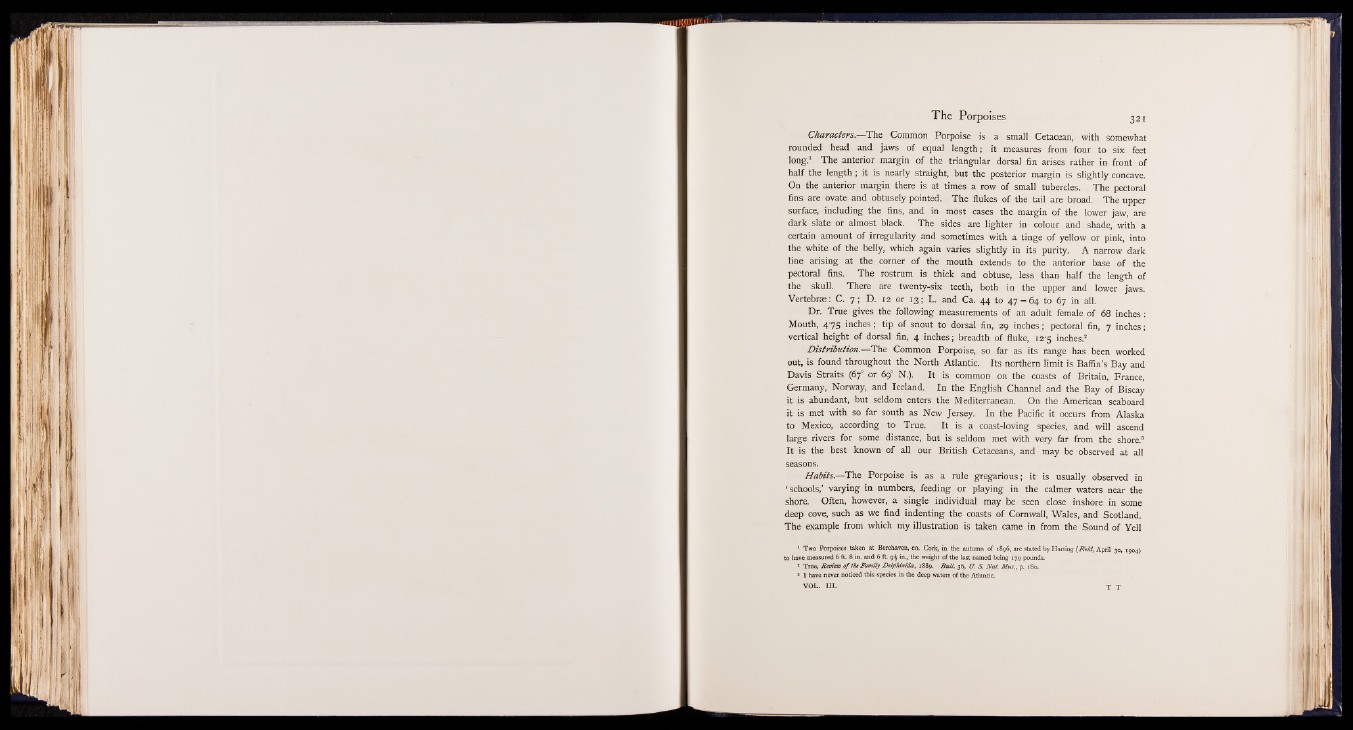
The Porpoises 321
Characters. The Common Porpoise is a small Cetacean, with somewhat
rounded head and jaws of equal length; it measures from four to six feet
long.1 The anterior margin of the triangular dorsal fin arises rather in front of
half the length ; it is nearly straight, but the posterior margin is slightly concave.
On the anterior margin there is at times a row of small tubercles. The pectoral
fins are ovate and obtusely pointed. The flukes of the tail are broad. The upper
surface, including the fins, and in most cases the margin of the lower jaw, are
dark slate or almost black. The sides are lighter in colour and shade, with a
certain amount of irregularity and sometimes with a tinge of yellow or pink, into
the white of the belly, which again varies slightly in its purity. A narrow dark
line arising at the corner of the mouth extends to the anterior base of the
pectoral fins. The rostrum is thick and obtuse, less than half the length of
the skull. There are twenty-six teeth, both in the upper and lower jaws.
Vertebrae: C. 7 ; D. 12 or 13; L. and Ca. 44 to 47 = 64 to 67 in all.
Dr. True gives the following measurements of an adult female of 68 inches :
Mouth, 475 inches; tip of snout to dorsal fin, 29 inches; pectoral fin, 7 inches;
vertical height of dorsal fin, 4 inches; breadth of fluke, 125 inches.8
Distribution.— The Common Porpoise, so far as its range has been worked
out, is found throughout the North Atlantic. Its northern limit is Baffin’s Bay and
Davis Straits (67 or 69° N.). It is common on the coasts of Britain, France,
Germany, Norway, and Iceland. In the English' Channel and the Bay of Biscay
it is abundant, but seldom enters the Mediterranean. On the American seaboard
it is met with so far south as New Jersey. In the Pacific it occurs from Alaska
to Mexico, according to True. It is a coast-loving species, and will ascend
large rivers for some distance, hut is seldom met with very far from the shore.“
It is the best known of all pur British Cetaceans, and may be observed at all
seasons.
Habits.— The Porpoise is as a rule gregarious; it is usually observed in
‘ schools,’ varying in numbers, feeding or playing in the calmer waters near the
shore. Often, however, a single individual may be seen close inshore in some
deep cove, such as we find indenting the coasts of Cornwall, Wales, and Scotland.
The example from which my illustration is taken came in from the Sound of Yell 1 *
3 1 Two Porpoises taken at Berehaven, co. Cork, in the autumn of 1896, are stated by Harting {Field, April 30, 1904)
to have measured 6 ft. 8 in. and 6 ft. 9^ in., the weight of the last named being 179 pounds.
s True, Review o f the Family Delphinidee, 1889. B u ll 36, U. S. Nat. Mus., p. 180.
3 I have never noticed this species in the deep waters of the Atlantic.
VOL. III. T T